Exploring Water Blow Nusa Dua
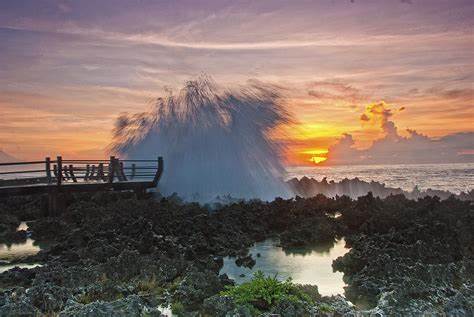
Exploring Water Blow Nusa Dua. Bali is home to a wide range of stunning natural attractions, from verdant rice terraces to majestic waterfalls, and some of the most pristine beaches in the world. Among these incredible sights is the Water Blow in Nusa Dua, a hidden gem that offers visitors a front-row seat to one of nature’s most dramatic shows. Water Blow is a natural phenomenon where powerful waves from the Indian Ocean crash against the jagged limestone cliffs, sending water soaring into the air, creating a breathtaking display of raw energy.
Located on the southeastern coast of Bali’s upscale Nusa Dua resort area, the Water Blow has become one of the most popular attractions for those looking to experience the untamed beauty of the ocean. This article will guide you through everything you need to know about the Water Blow, from how to get there and what to expect, to tips for making the most of your visit.
1. What Is Water Blow?
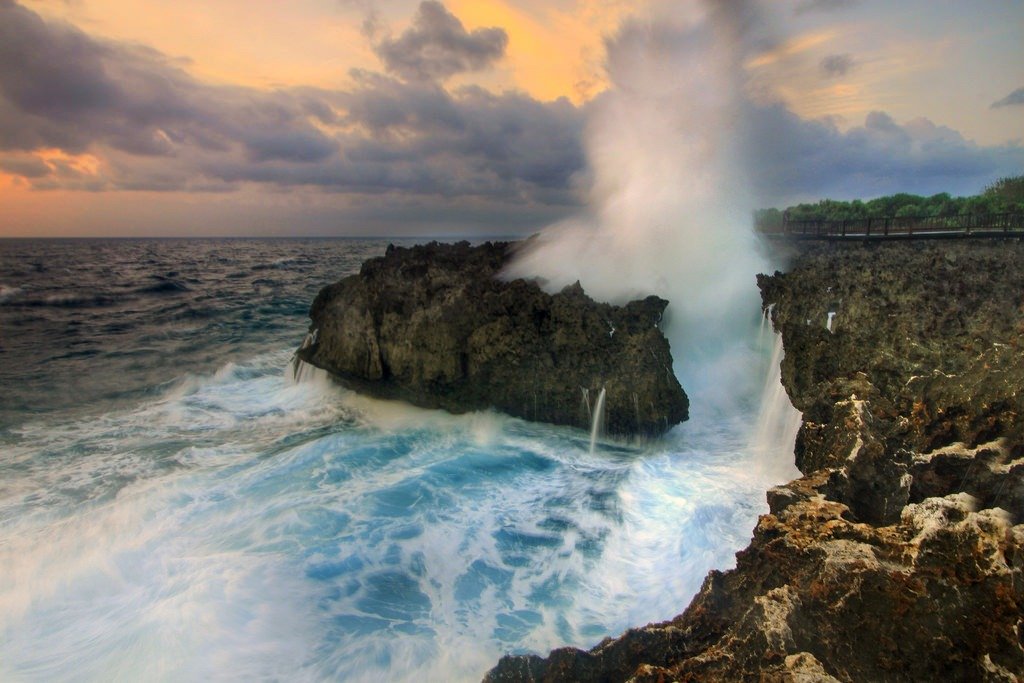
The Water Blow is a natural phenomenon caused by ocean waves that hit narrow openings in the coastal cliffs, resulting in bursts of water that can shoot up to 30 feet or more into the air. The process occurs as the waves are funneled through the rock formations, creating immense pressure and sending water erupting skyward. It’s an incredible sight that combines the sheer force of the ocean with the beauty of Bali’s coastline.
This display is not constant but occurs when large waves crash into the shore, making it more spectacular during high tide or when the sea is rough. The Water Blow is not just about watching the water shoot up into the air; it’s about experiencing the sound of the waves, the power of nature, and the excitement of standing close to such a dynamic force.
2. Location and How to Get There
The Water Blow is located within the lush Nusa Dua Peninsula, in a beautifully maintained park near the luxurious hotels and resorts that dot the Nusa Dua coastline. The area around the Water Blow is open to the public and easily accessible by car, scooter, or on foot for those staying in the Nusa Dua resort area.
To get to the Water Blow from the main part of Nusa Dua, simply follow the well-marked paths leading through the coastal gardens. The site is a short walk from Nusa Dua Beach and the popular Bali Collection shopping center, making it a convenient stop for anyone exploring the area. The path leading to the Water Blow is scenic, passing through well-manicured lawns, palm trees, and coastal rock formations. There are clear signs that guide visitors directly to the Water Blow, ensuring an easy and enjoyable walk to the viewpoint.
For visitors coming from other parts of Bali, it’s about a 30-40 minute drive from Kuta or Seminyak, depending on traffic. The site has ample parking, and since it’s part of the larger Nusa Dua complex, there are plenty of restaurants and facilities nearby.
3. What to Expect at Water Blow
As you approach the Water Blow, you’ll start to hear the crashing of the waves against the cliffs before you even see it. The sound is thunderous, adding to the anticipation of what’s to come. Once you reach the designated viewing platform, you’ll be treated to a mesmerizing display of nature as the ocean’s waves surge into the narrow opening of the cliffs, creating towering sprays of water.
The area around the Water Blow is equipped with a wooden boardwalk and observation platforms, ensuring visitors can get as close as safely possible to the action. Depending on the tide and wave size, the water can spray quite high, and it’s not uncommon for visitors to get a little wet from the mist. Many people come prepared with waterproof jackets or umbrellas, especially if they plan to stand close to the edge.
The observation platform offers panoramic views of the Indian Ocean, and on a clear day, you can see the vast expanse of the blue sea stretching into the horizon. The waves constantly change in size and force, so no two visits to the Water Blow are ever the same. This unpredictability is part of what makes the experience so thrilling.
4. Best Time to Visit Water Blow

Timing is key to experiencing the Water Blow at its most dramatic. The phenomenon is most impressive during high tide, when the waves are larger and hit the cliffs with more force. The best time to visit is usually in the afternoon, when the tides tend to be higher, and the sunlight illuminates the water, making the sprays even more dazzling.
During the dry season, from May to September, the weather is sunny and clear, providing perfect conditions for visiting the Water Blow. The dry season also brings larger swells, making the ocean more active, which is ideal for viewing the water bursts. While the Water Blow is accessible year-round, visiting during the rainy season (October to April) may result in cloudy skies and less visibility, although the waves can still be powerful during storms.
5. Exploring the Surrounding Area
In addition to the Water Blow, the surrounding area offers plenty of opportunities for exploration and relaxation. Nusa Dua Beach, one of Bali’s most beautiful and tranquil beaches, is just a short walk away. The beach is known for its soft white sand and calm, clear waters, making it ideal for swimming, sunbathing, or simply relaxing after visiting the Water Blow.
Nearby, the Nusa Dua Peninsula is home to several luxury resorts, spas, and world-class restaurants. Many visitors choose to combine a visit to the Water Blow with a stay in one of the high-end hotels in the area, where they can enjoy five-star service, beachfront views, and a range of amenities.
The Bali Collection, a large open-air shopping and dining complex, is also within walking distance of the Water Blow. It’s a great place to grab a meal, shop for souvenirs, or relax with a coffee or cocktail after spending time exploring the coast.
6. Tips for Visiting Water Blow Nusa Dua
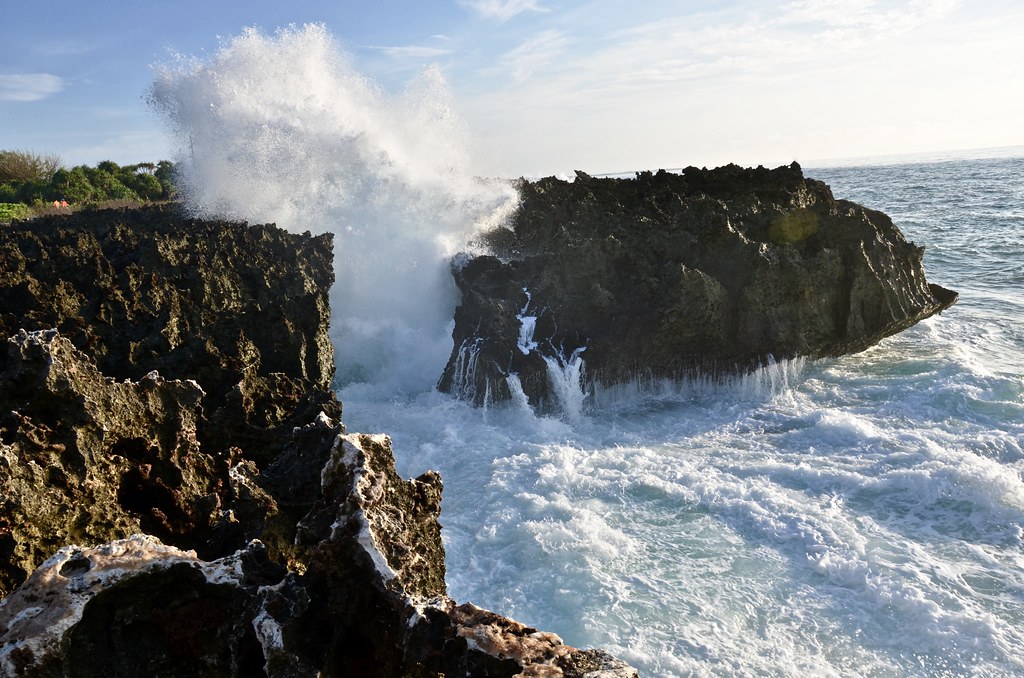
- Wear Waterproof Clothing: Depending on the strength of the waves, you might get sprayed with water as you watch the Water Blow. Bringing a waterproof jacket or poncho can help keep you dry, especially if you plan to stand near the front of the platform.
- Protect Your Electronics: If you’re bringing a camera or smartphone to capture the spectacle, consider using a waterproof case to protect your device from the mist and spray.
- Timing Matters: For the best experience, visit during high tide when the waves are at their strongest. Check the tide schedule before you go to ensure you catch the Water Blow at its peak.
- Stay Safe: The waves at the Water Blow are powerful, and it’s essential to stay behind the designated barriers and follow any safety instructions. The cliffs can be slippery, so be cautious when walking near the edge.
- Plan to Spend a Few Hours: The Water Blow itself is a quick stop, but the surrounding area is worth exploring. Spend some time walking along the Nusa Dua promenade, relaxing on the beach, or visiting nearby attractions like the Peninsula Island or the Puja Mandala complex.
7. Why Visit Water Blow?
The Water Blow is a must-see for anyone visiting Nusa Dua or Bali as a whole. It offers a rare opportunity to witness the sheer power of the ocean in a dramatic, up-close setting. The natural beauty of the area, combined with the spectacle of the water exploding into the air, makes it an unforgettable experience for travelers of all ages.
Beyond the Water Blow itself, Nusa Dua’s upscale atmosphere, pristine beaches, and luxurious amenities make it one of the best places in Bali to unwind and enjoy the island’s natural beauty in comfort. Whether you’re staying in the area or making a day trip from another part of Bali, the Water Blow is well worth the visit.
Water Blow Nusa Dua is one of Bali’s most captivating natural attractions, offering visitors the chance to see the ocean’s raw power in a serene, luxurious setting. With its spectacular displays of crashing waves, panoramic ocean views, and nearby attractions, it’s the perfect stop for those looking to explore more of Bali’s coastal beauty.
Whether you’re a nature lover, photographer, or simply seeking a peaceful spot to relax, the Water Blow is sure to leave a lasting impression. Make sure to add it to your itinerary the next time you visit Bali’s beautiful Nusa Dua region.





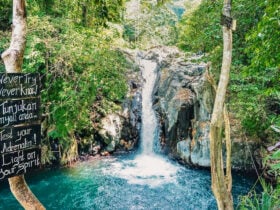
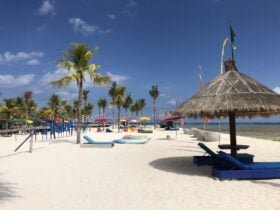



Leave a Review